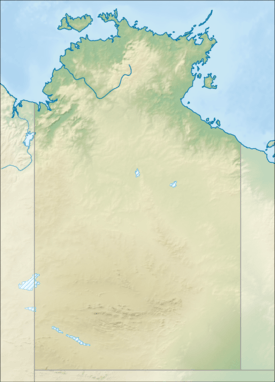Mac Clark (Acacia peuce) Conservation Reserve
| Mac Clark (Acacia peuce) Conservation Reserve Northern Territory | |
|---|---|
|
IUCN category Ia (strict nature reserve) | |
 Adult Acacia peuce tree | |
 Mac Clark (Acacia peuce) Conservation Reserve | |
| Coordinates | 25°07′18″S 135°30′29″E / 25.12167°S 135.50806°ECoordinates: 25°07′18″S 135°30′29″E / 25.12167°S 135.50806°E |
| Established | 1982[1] |
| Area | 3,042 hectares (7,517 acres)[1] |
| Managing authorities | Parks and Wildlife Commission |
| See also | Protected areas of the Northern Territory |
Mac Clark (Acacia peuce) Conservation Reserve is a conservation reserve in the Alice Springs region of the Northern Territory of Australia.
It is located approximately approximately 130 kilometres (81 mi) south of Ltyentye Apurte Community and 290 kilometres (180 mi) south east of Alice Springs. The reserve is surrounded by the pastoral lease and operating cattle station, Andado, the area also lies on the western edge of the Simpson Desert.
The area is fenced to protect it from stock. It can be accessed via the old Andado track or the Binns track via Ltyentye Apurte Community or from Kulgera via the Stuart Highway.[2]
Occupying an area of 3,042 hectares (7,517 acres) the landscape in a flat, stony windswept plain in one of the hottest places in Australia. with temperatures often exceeding 40 °C (104 °F) in summer and an annual rainfall of about 150 millimetres (6 in).[3]
The traditional owners of the area are the Arrente peoples who lived and travelled through the area for thousands of years. The area is rich in Aboriginal artefacts and the name of the pastoral lease is derived from the Arrente word meaning stone tool.[4][5]
Europeans arrived in the area in the 1880s and settled the lands for pastoralism, raising both sheep and more recently cattle. Malcolm Mac Clark and his wife Molly arrived at Andado Station in 1955,[5] Mac Died of a heart attack in 1978. The reserve bears his name as a result of his interest in conserving the trees found there.[3]
The reserve was established to preserve the rare Acacia peuce tree, also known as Waddywood, of which there is a stand of 1,000 mature trees found within the reserve. During the 1900s most of these trees had been cut down to make shelters and stockyards until there were only three populations left: One at Andado, another near to Birdsville and the last near Boulia.[2] In an area where only a few shrubs and grasses are able to survive Acacia peuce thrives and is able to grow to a height of 17 metres (56 ft) and can live for up to 500 years.[3] Prolonged drought, fire, rabbits and livestock are all a threat to any seedlings. Studies are being conducted in the area on regeneration rate and growth rate of the trees.[3]
See also
Protected areas of the Northern Territory
References
- 1 2 "Terrestrial Protected Areas by Reserve Type in the Northern Territory (2012)". Department of Environment. 2012. Retrieved 12 April 2015.
- 1 2 "Fact Sheet - Mac Clark (Acacia peuce) Conservation Reserve" (PDF). Northern Territory Government. 2010. Retrieved 15 April 2015.
- 1 2 3 4 "Mac Clark (Acacia Peuce) Conservation Reserve". Parks and Wildlife Commission. Retrieved 16 April 2015.
- ↑ "Heritage Notes - Mac Clark Conservation Reserve" (PDF). Heritage Advisory Council. 22 July 2002. Retrieved 16 April 2015.
- 1 2 "Life and History". Old Andado Station. Retrieved 16 April 2015.